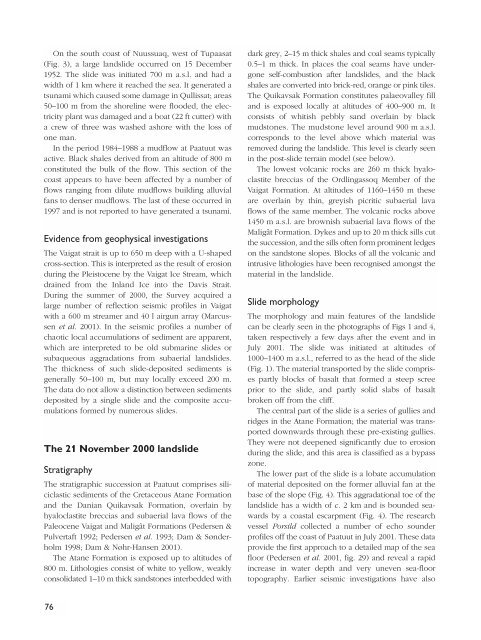Review of Greenland Avtivities 2001 - Geus
Review of Greenland Avtivities 2001 - Geus
Review of Greenland Avtivities 2001 - Geus
Create successful ePaper yourself
Turn your PDF publications into a flip-book with our unique Google optimized e-Paper software.
On the south coast <strong>of</strong> Nuussuaq, west <strong>of</strong> Tupaasat<br />
(Fig. 3), a large landslide occurred on 15 December<br />
1952. The slide was initiated 700 m a.s.l. and had a<br />
width <strong>of</strong> 1 km where it reached the sea. It generated a<br />
tsunami which caused some damage in Qullissat; areas<br />
50–100 m from the shoreline were flooded, the electricity<br />
plant was damaged and a boat (22 ft cutter) with<br />
a crew <strong>of</strong> three was washed ashore with the loss <strong>of</strong><br />
one man.<br />
In the period 1984–1988 a mudflow at Paatuut was<br />
active. Black shales derived from an altitude <strong>of</strong> 800 m<br />
constituted the bulk <strong>of</strong> the flow. This section <strong>of</strong> the<br />
coast appears to have been affected by a number <strong>of</strong><br />
flows ranging from dilute mudflows building alluvial<br />
fans to denser mudflows. The last <strong>of</strong> these occurred in<br />
1997 and is not reported to have generated a tsunami.<br />
Evidence from geophysical investigations<br />
The Vaigat strait is up to 650 m deep with a U-shaped<br />
cross-section. This is interpreted as the result <strong>of</strong> erosion<br />
during the Pleistocene by the Vaigat Ice Stream, which<br />
drained from the Inland Ice into the Davis Strait.<br />
During the summer <strong>of</strong> 2000, the Survey acquired a<br />
large number <strong>of</strong> reflection seismic pr<strong>of</strong>iles in Vaigat<br />
with a 600 m streamer and 40 l airgun array (Marcussen<br />
et al. <strong>2001</strong>). In the seismic pr<strong>of</strong>iles a number <strong>of</strong><br />
chaotic local accumulations <strong>of</strong> sediment are apparent,<br />
which are interpreted to be old submarine slides or<br />
subaqueous aggradations from subaerial landslides.<br />
The thickness <strong>of</strong> such slide-deposited sediments is<br />
generally 50–100 m, but may locally exceed 200 m.<br />
The data do not allow a distinction between sediments<br />
deposited by a single slide and the composite accumulations<br />
formed by numerous slides.<br />
The 21 November 2000 landslide<br />
Stratigraphy<br />
The stratigraphic succession at Paatuut comprises siliciclastic<br />
sediments <strong>of</strong> the Cretaceous Atane Formation<br />
and the Danian Quikavsak Formation, overlain by<br />
hyaloclastite breccias and subaerial lava flows <strong>of</strong> the<br />
Paleocene Vaigat and Maligât Formations (Pedersen &<br />
Pulvertaft 1992; Pedersen et al. 1993; Dam & Sønderholm<br />
1998; Dam & Nøhr-Hansen <strong>2001</strong>).<br />
The Atane Formation is exposed up to altitudes <strong>of</strong><br />
800 m. Lithologies consist <strong>of</strong> white to yellow, weakly<br />
consolidated 1–10 m thick sandstones interbedded with<br />
dark grey, 2–15 m thick shales and coal seams typically<br />
0.5–1 m thick. In places the coal seams have undergone<br />
self-combustion after landslides, and the black<br />
shales are converted into brick-red, orange or pink tiles.<br />
The Quikavsak Formation constitutes palaeovalley fill<br />
and is exposed locally at altitudes <strong>of</strong> 400–900 m. It<br />
consists <strong>of</strong> whitish pebbly sand overlain by black<br />
mudstones. The mudstone level around 900 m a.s.l.<br />
corresponds to the level above which material was<br />
removed during the landslide. This level is clearly seen<br />
in the post-slide terrain model (see below).<br />
The lowest volcanic rocks are 260 m thick hyaloclastite<br />
breccias <strong>of</strong> the Ordlingassoq Member <strong>of</strong> the<br />
Vaigat Formation. At altitudes <strong>of</strong> 1160–1450 m these<br />
are overlain by thin, greyish picritic subaerial lava<br />
flows <strong>of</strong> the same member. The volcanic rocks above<br />
1450 m a.s.l. are brownish subaerial lava flows <strong>of</strong> the<br />
Maligât Formation. Dykes and up to 20 m thick sills cut<br />
the succession, and the sills <strong>of</strong>ten form prominent ledges<br />
on the sandstone slopes. Blocks <strong>of</strong> all the volcanic and<br />
intrusive lithologies have been recognised amongst the<br />
material in the landslide.<br />
Slide morphology<br />
The morphology and main features <strong>of</strong> the landslide<br />
can be clearly seen in the photographs <strong>of</strong> Figs 1 and 4,<br />
taken respectively a few days after the event and in<br />
July <strong>2001</strong>. The slide was initiated at altitudes <strong>of</strong><br />
1000–1400 m a.s.l., referred to as the head <strong>of</strong> the slide<br />
(Fig. 1). The material transported by the slide comprises<br />
partly blocks <strong>of</strong> basalt that formed a steep scree<br />
prior to the slide, and partly solid slabs <strong>of</strong> basalt<br />
broken <strong>of</strong>f from the cliff.<br />
The central part <strong>of</strong> the slide is a series <strong>of</strong> gullies and<br />
ridges in the Atane Formation; the material was transported<br />
downwards through these pre-existing gullies.<br />
They were not deepened significantly due to erosion<br />
during the slide, and this area is classified as a bypass<br />
zone.<br />
The lower part <strong>of</strong> the slide is a lobate accumulation<br />
<strong>of</strong> material deposited on the former alluvial fan at the<br />
base <strong>of</strong> the slope (Fig. 4). This aggradational toe <strong>of</strong> the<br />
landslide has a width <strong>of</strong> c. 2 km and is bounded seawards<br />
by a coastal escarpment (Fig. 4). The research<br />
vessel Porsild collected a number <strong>of</strong> echo sounder<br />
pr<strong>of</strong>iles <strong>of</strong>f the coast <strong>of</strong> Paatuut in July <strong>2001</strong>. These data<br />
provide the first approach to a detailed map <strong>of</strong> the sea<br />
floor (Pedersen et al. <strong>2001</strong>, fig. 29) and reveal a rapid<br />
increase in water depth and very uneven sea-floor<br />
topography. Earlier seismic investigations have also<br />
76

















